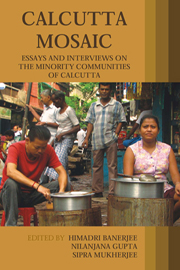Book contents
- Frontmatter
- Contents
- List of Contributors
- Acknowledgements
- Introduction
- 1 Mapping the Spaces of Minorities
- 2 The Armenians of Calcutta
- 3 The Jews of Calcutta: An Interview with Michael Ezra
- 4 The Sindhis of Calcutta
- 5 The City of Colleges
- 6 The Chinese Community of Calcutta
- 7 The Anglo–Indians of Calcutta
- 8 The Biharis of Calcutta
- 9 Agraharis of Calcutta
- 10 A Journey into My Neighbourhood
- 11 The ‘South Indians’ of Calcutta: Experiences in Cultural Processes
- 12 ‘Non-Bengali’ Icons of Malevolence
- 13 Selfing the City
9 - Agraharis of Calcutta
A Minority Group within the Larger Sikh Community
Published online by Cambridge University Press: 05 March 2012
- Frontmatter
- Contents
- List of Contributors
- Acknowledgements
- Introduction
- 1 Mapping the Spaces of Minorities
- 2 The Armenians of Calcutta
- 3 The Jews of Calcutta: An Interview with Michael Ezra
- 4 The Sindhis of Calcutta
- 5 The City of Colleges
- 6 The Chinese Community of Calcutta
- 7 The Anglo–Indians of Calcutta
- 8 The Biharis of Calcutta
- 9 Agraharis of Calcutta
- 10 A Journey into My Neighbourhood
- 11 The ‘South Indians’ of Calcutta: Experiences in Cultural Processes
- 12 ‘Non-Bengali’ Icons of Malevolence
- 13 Selfing the City
Summary
Sikh migration to the West is well-known. The voice of these rich overseas Sikhs signifies a powerful political force in the current Punjab situation. It is generally communicated through electronic mail, telephonic conversation, postal correspondence, print media, regular remittance and marriage network. Contemporary Punjab leadership also shows respect to this opinion.
The situation is slightly different for Agraharis of Calcutta. They initially came from Bihar more than two hundred years ago, and represent one of the earliest settlers in the city. Neither are they regular visitors of the Harimandir Sahib in Amritsar nor do their views ever figure in any serious public platform. Demographically speaking, they constitute a microscopic minority representing less than .01 per cent of the total population of the metropolis. By virtue of long residence in Calcutta, their lifestyle and taste have increasingly converged with those of the local milieu. They know Bengali well but communicate in their mother tongue (Bhojpuri) when they interact amongst themselves. These Sikhs do not know Punjabi and prefer to maintain a line of demarcation from the numerically dominant Punjabi-speaking Sikhs in the locality. In terms of ethnic identity and physical distinctiveness, the native Sikhs have very little in common with their Punjabi counterparts of the region. The latter constitute a larger group and represent approximately .01 per cent of Calcutta's population. They do not consider Agraharis to be their equals or even pukka (true) Sikhs. To them these indigenous Sikhs are a little sluggish in maintaining the Sikh communal identity markers.
- Type
- Chapter
- Information
- Calcutta MosaicEssays and Interviews on the Minority Communities of Calcutta, pp. 164 - 196Publisher: Anthem PressPrint publication year: 2009
- 1
- Cited by



